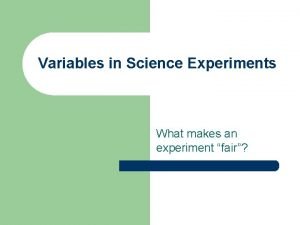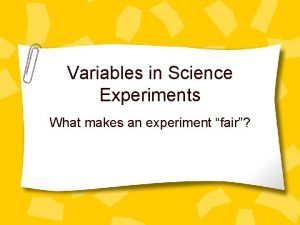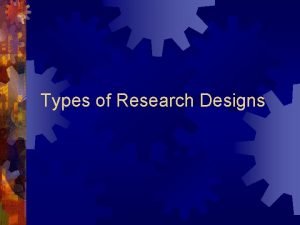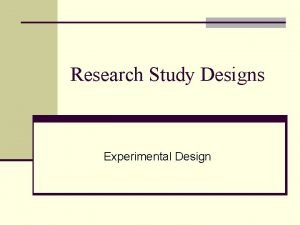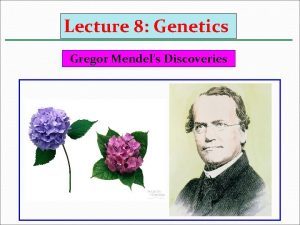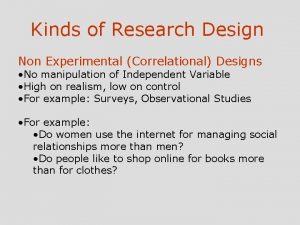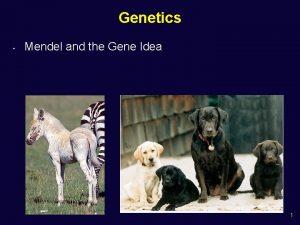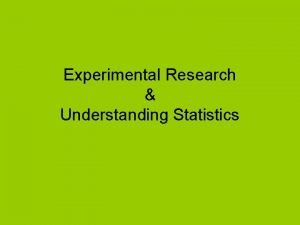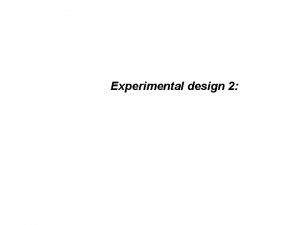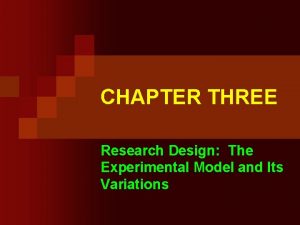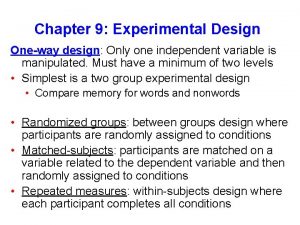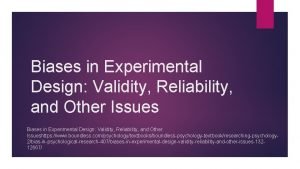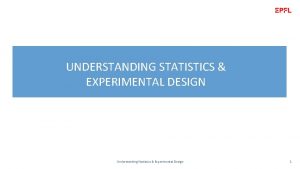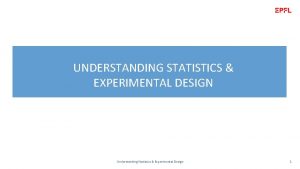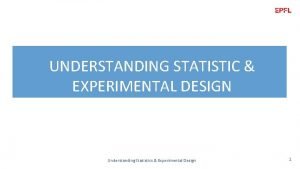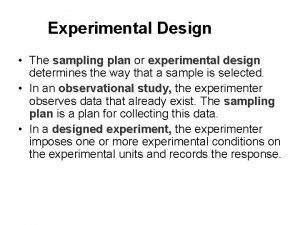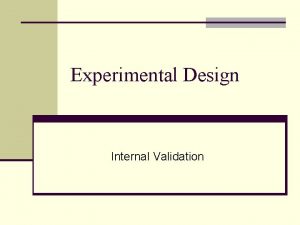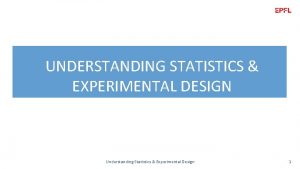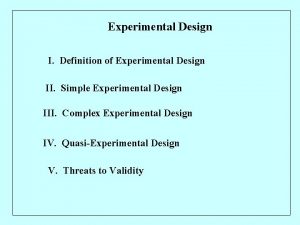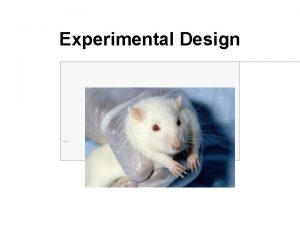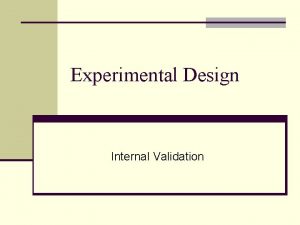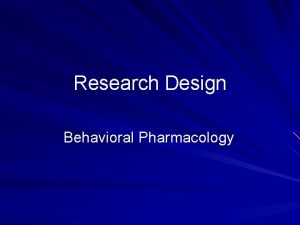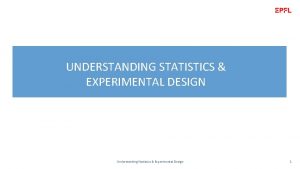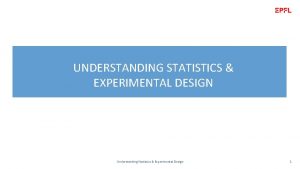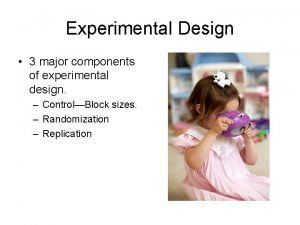EXPERIMENTAL DESIGN EXPERIMENTAL DESIGN AIM 1 How can






























- Slides: 30

EXPERIMENTAL DESIGN

EXPERIMENTAL DESIGN AIM: 1. How can we design and diagram a completely randomized experiment? 2. What is single and double blinding? 3. How can we design and diagram a randomized block design experiment?

THE STAT Handout � Pine Trees Resisting Drought � Package Liners � Teaching Methods

TOMATO PLANT EXAMPLE REVISITED You wish to run an experiment to test a new fertilizer and the amount of sun that tomato plants get on the juiciness and taste of their tomatoes. � Factor – Sunlight Full sun Partly sunny � Factor – Fertilizer Full Fertilizer Dose Half Fertilizer Dose No Fertilizer How many treatments? 2 • 3 = 6 treatments

NAME ALL SIX TREATMENTS Full Sun – Full Dose Fertilizer Full Sun – Half Dose Fertilizer Full Sun – No Fertilizer Partly Sunny – Full Dose Fertilizer Partly Sunny – Half Dose Fertilizer Partly Sunny – No Fertilizer

DRAW A DIAGRAM TO DEPICT THIS EXPERIMENT – ASSUME WE ARE ONLY LOOKING AT THE FERTILIZER FACTOR Assume there 24 plants from the garden store.

BLINDING – WHAT IS IT AND WHY DO WE NEED IT? Humans are very susceptible to errors in judgment.

BLINDING – WHAT IS IT AND WHY DO WE NEED IT? Humans are very susceptible to errors in judgment. Who should be blinded?

BLINDING – WHAT IS IT AND WHY DO WE NEED IT? Humans are very susceptible to errors in judgment. Who should be blinded?

BLINDING – WHAT IS IT AND WHY DO WE NEED IT? Humans are very susceptible to errors in judgment. Who should be blinded? Subjects should not know which treatment they are receiving – placebo effect.

BLINDING – WHAT IS IT AND WHY DO WE NEED IT? Humans are very susceptible to errors in judgment. Who should be blinded? Subjects should not know which treatment they are receiving – placebo effect. Experimenters themselves often subconsciously behave in ways that favor what they believe [expectations].

BLINDING – WHAT IS IT AND WHY DO WE NEED IT? Humans are very susceptible to errors in judgment. Who should be blinded? Subjects should not know which treatment they are receiving – placebo effect. Experimenters themselves often subconsciously behave in ways that favor what they believe [expectations]. In general, anyone who could impact the outcome should be blinded.

SINGLE VS. DOUBLE BLINDING Two main classes of individuals who affect the outcome of the experiment:

SINGLE VS. DOUBLE BLINDING Two main classes of individuals who affect the outcome of the experiment: 1. Those who could influence the results Subjects B. Treatment administrators C. technicians A.

SINGLE VS. DOUBLE BLINDING Two main classes of individuals who affect the outcome of the experiment: 1. Those who could influence the results Subjects B. Treatment administrators C. technicians A. 2. Those who evaluate the results Judges B. Physicians A.

SINGLE VS. DOUBLE BLINDING Two main classes of individuals who affect the outcome of the experiment: 1. Those who could influence the results Subjects B. Treatment administrators C. technicians A. 2. Those who evaluate the results Judges B. Physicians A. If everyone in one of these classes is blinded – Single Blind.

SINGLE VS. DOUBLE BLINDING Two main classes of individuals who affect the outcome of the experiment: 1. Those who could influence the results A. B. C. 2. Subjects Treatment administrators technicians Those who evaluate the results A. B. Judges Physicians If everyone in one of these classes is blinded – Single Blind. If everyone on both of these classes is blinded – Double Blind.

BACK TO OUR TOMATO EXAMPLE Tomatoes are not people. Do we need blinding?

BACK TO OUR TOMATO EXAMPLE Tomatoes are not people. Do we need blinding? Double blinding should be used for most reliable results: � Blind They could influence the results. � Blind the caretakers of the tomato plants the judges of the juiciness / tastiness They evaluate the results.

MEDIATION FOR ANXIETY EXAMPLE An experiment that claimed to show that mediation lowers anxiety proceeded as follows. The experimenter interviewed the subjects and rated their level of anxiety. Then the subjects were randomly assigned to two groups. The experimenter taught one group how to meditate and they meditated daily for a month. The other groups was simply told to relax more. At the end of the month, the experimenter interviewed al the subjects again and rated their anxiety level. The meditation group now had less anxiety. Psychologists said that the results were suspect because the ratings were not blind. Explain what this means and how lack of blindness could bias the results.

MEDIATION FOR ANXIETY EXAMPLE SOLUTION Because the experimenter knew which subjects had learned the meditation techniques, he (or she) may have had some expectations about the outcome of the experiment: if the experimenter believed that meditation was beneficial, he/she may subconsciously rate that group as being less anxious.

PAIN RELIEF STUDY EXAMPLE Fizz Laboratories has developed a new pain-relief medication. Sixty patients suffering from arthritis and needing pain relief are available. Each patient will be treated and asked an hour later, “About what percentage of pain relief did you experience? ” A. Why should Fizz not simply administer the new drug and record the patient responses? B. Outline the design of an experiment to compare the drug’s effectiveness with that of aspirin and of a placebo. C. Should patients be told which drug they are receiving? How would this knowledge affect their reactions? D. If patients are not told which treatment they are receiving, the experiment is single blind. Should this experiment be double-blind also? Explain.

FIZZ LABS SOLUTION A. B. C. D. If only the new drug is administered, there is nothing to compare to. Randomly assign 20 patients to each of the treatment groups. After treatment, ask about pain relief. Compare average pain relief experienced in each group. The subjects should not know which drug they are receiving – expectations impacted. Yes, if not double blind, the researchers may subtly influence subjects into giving responses that support the new medication.

NOW LET’S TALK ABOUT BLOCKING Let’s return to our tomato example, suppose we know that our tomato plants were purchased from two different nurseries (A and B) and that the conditions in the two nurseries are not the same.

NOW LET’S TALK ABOUT BLOCKING Let’s return to our tomato example, suppose we know that our tomato plants were purchased from two different nurseries (A and B) and that the conditions in the two nurseries are not the same. Since the stores may vary in the care they give their plants – this may impact their juiciness and tastiness.

NOW LET’S TALK ABOUT BLOCKING Let’s return to our tomato example, suppose we know that our tomato plants were purchased from two different nurseries (A and B) and that the conditions in the two nurseries are not the same. Since the stores may vary in the care they give their plants – this may impact their juiciness and tastiness. We are better off BLOCKING by store.

NOW LET’S TALK ABOUT BLOCKING Let’s return to our tomato example, suppose we know that our tomato plants were purchased from two different nurseries (A and B) and that the conditions in the two nurseries are not the same. Since the stores may vary in the care they give their plants – this may impact their juiciness and tastiness. We are better off BLOCKING by store. BLOCKING isolates the effect of the some shared characteristic that may impact the response variable.

BLOCKING TOMATOES We assign the plants to blocks based on store. This part is NOT random. Then, we assign experimental units to treatments randomly WITHIN each block. Notice that the response variable is compared ONLY within blocks.

STATISTICALLY SIGNIFICANT So, we got a difference. How do we know if this difference is large enough to matter?

STATISTICALLY SIGNIFICANT So, we got a difference. How do we know if this difference is large enough to matter? A result is statistically significant if it is unlikely to happen by random chance alone.
 Experimental vs nonexperimental research
Experimental vs nonexperimental research Experimental vs non experimental
Experimental vs non experimental Experimental vs non experimental
Experimental vs non experimental Disadvantages of experimental research
Disadvantages of experimental research Nonexperimental study
Nonexperimental study Independent variable science
Independent variable science Experimental design independent and dependent variables
Experimental design independent and dependent variables Crossover design slideshare
Crossover design slideshare Quasi experimental design example
Quasi experimental design example N-of-1 study example
N-of-1 study example Non experimental research topics
Non experimental research topics Non experimental design
Non experimental design Characteristics of experimental research design
Characteristics of experimental research design Principles of experimental design
Principles of experimental design Mendel's experimental design
Mendel's experimental design Mendel's three laws
Mendel's three laws Mendel's experimental design
Mendel's experimental design Non experimental correlational design
Non experimental correlational design In watermelons bitter fruit (b) is dominant
In watermelons bitter fruit (b) is dominant Ethical issues in experimental design
Ethical issues in experimental design Quasi experimental design notation
Quasi experimental design notation Matched pairs design
Matched pairs design Experimental design terminology
Experimental design terminology Experimental design cheat sheet
Experimental design cheat sheet A sales representative wishes to survey
A sales representative wishes to survey Good experimental design
Good experimental design Cohort meaning in research
Cohort meaning in research Classic experimental design
Classic experimental design One way experimental design
One way experimental design Mendel's experimental design
Mendel's experimental design Bias in experimental design
Bias in experimental design





